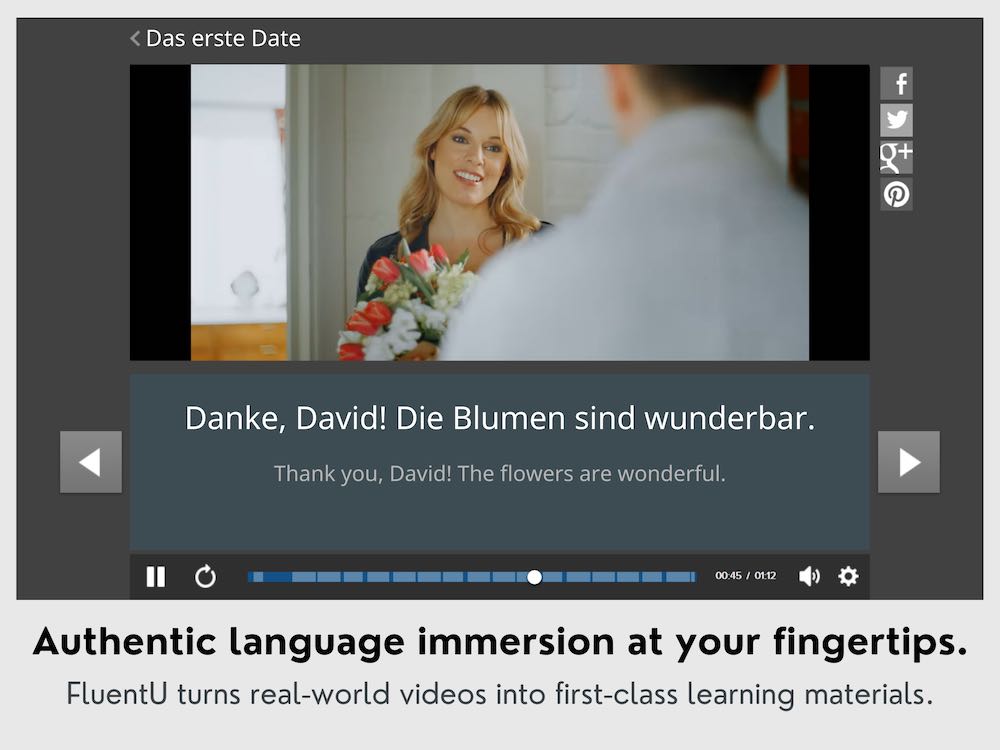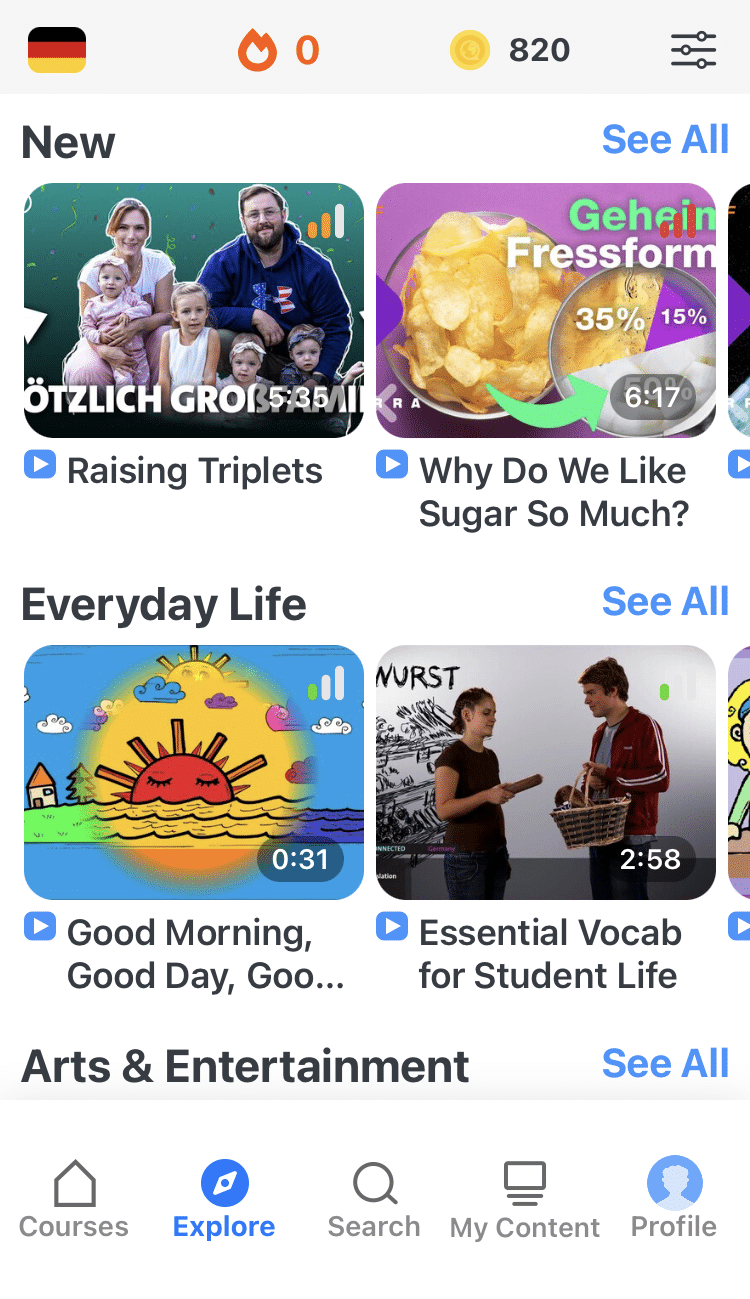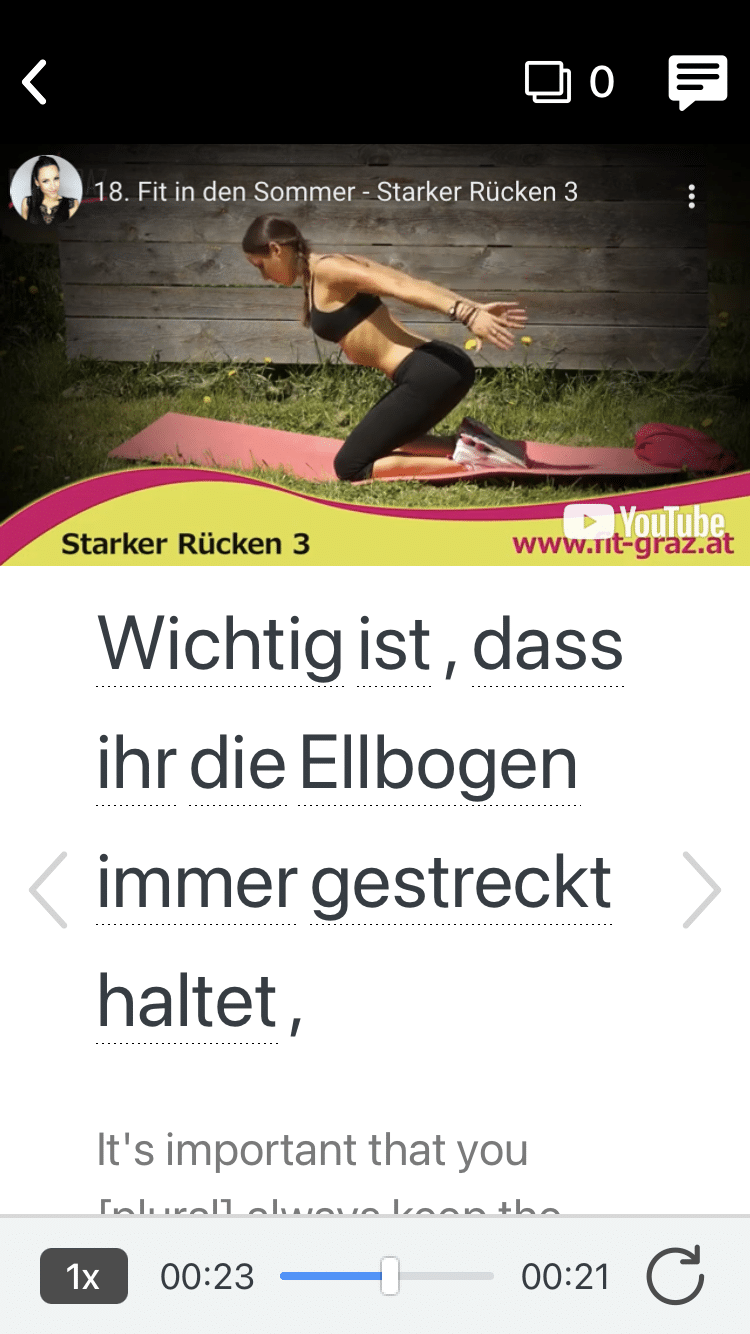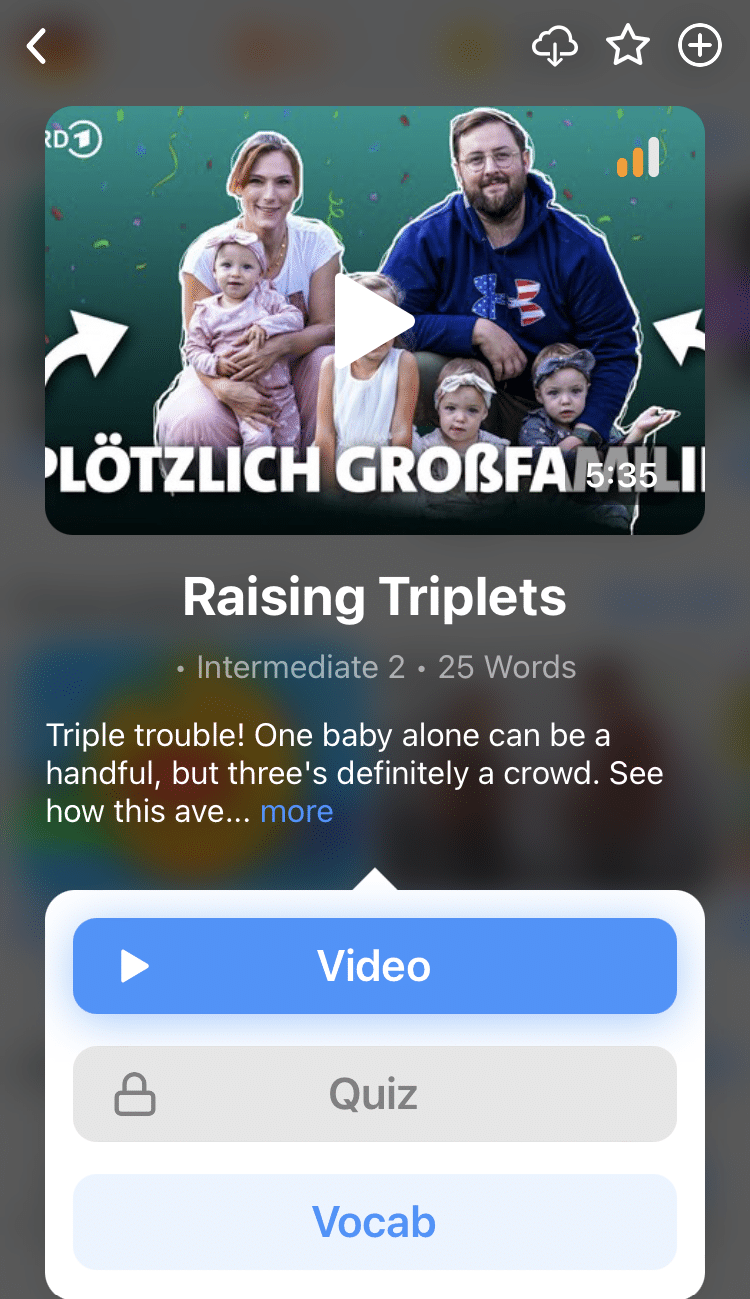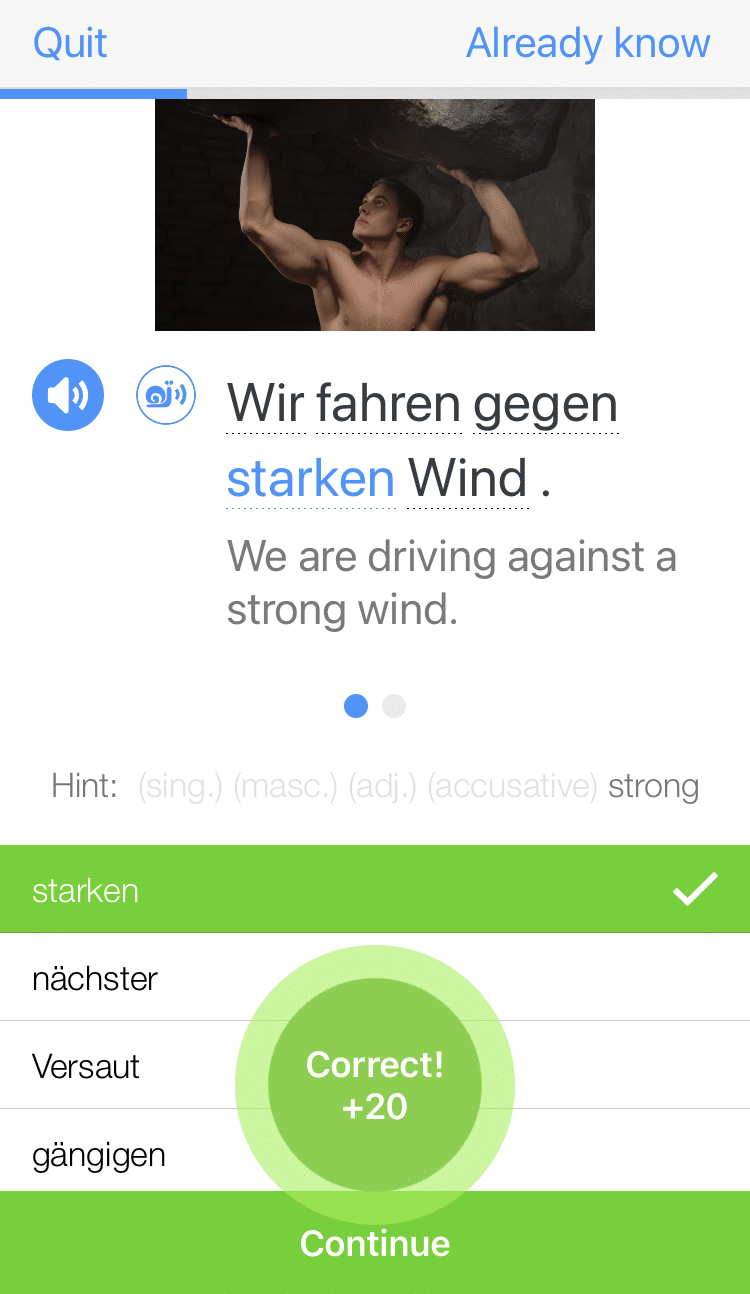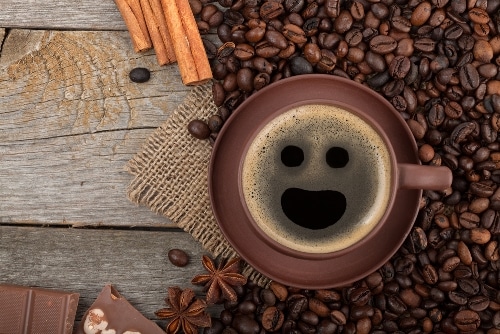
How to Order Coffee in German
Sometimes, before you can even start to think of speaking German…you just need that cup of coffee.
Which can be a cruel irony if you need to speak German to get your coffee.
But don’t despair—you can do it with a handful of key sentences!
Here’s a list of useful sentences for ordering coffee (or Kaffee in German), plus a bit of background on German café culture.
Contents
- Understanding the Café Culture in Germany
- How to Read a German Café Menu
- How to Order Coffee in German: 14 Phrases for Caffeine Aficionados
- 1. Einen Kaffee, bitte. (A coffee, please.)
- 2. Was können Sie empfehlen? (What would you recommend?)
- 3. Ich möchte… (I would like…)
- 4. Zum Mitnehmen (To take away)
- 5. Haben Sie…? (Do you have…?)
- 6. Achtung, es ist heiß. (Careful, it’s hot.)
- 7. Wo ist der Zucker? (Where is the sugar?)
- 8. Darf ich bitte die Speisekarte sehen? (May I see the menu, please?)
- 9. Wie viel kostet das? (How much does it cost?)
- 10. Welche Größe möchten Sie? (What size would you like?)
- 11. Sonst noch etwas? (Anything else?)
- 12. Ich bringe es Ihnen. (I will bring it to you.)
- 13. Wo sind die Toiletten, bitte? (Where are the bathrooms, please?)
- 14. Gibt es WLAN hier? (Is there WiFi here?)
- And One More Thing...
Download: This blog post is available as a convenient and portable PDF that you can take anywhere. Click here to get a copy. (Download)
Understanding the Café Culture in Germany
The history of coffee in Germany
Coffee snobs everywhere can rest assured that you’re unlikely to run into percolated coffee in Germany. Not only are the Germans proponents of filtered coffee—they created it. (Paper coffee filters were invented by Melitta Bentz in 1908, and the electronic drip brewer by Gottlob Widmann in 1954.)
Being a nation that leans more towards coffee than tea, Germany doesn’t mess around with this beloved beverage. They even have an annual “Day of Coffee.”
For more information about German coffee traditions, check out this post from the Coffee Tasting Club.
German cafés: Not just about the coffee
If you’re used to the American or British model of cafés, you may be shocked the first time you see a group sitting on the couches, drinking beer. Cafés in Germany not only serve alcohol, but tend to look more like bars as the evening progresses. It’s not unlikely for many cafés to clear out tables at night to make room for a party crowd.
If you’re looking for a quiet, relaxing place to curl up with a good book, however, have no fear. It’s still very much a quieter coffee crowd in the café in daylight and evening hours.
Another coffee option: German bakeries
Bakeries are everywhere in Germany. Not only can you find inexpensive fresh rolls and sandwiches, but you can get less pricy coffee as well. Although you may not have all the choices of a café, a cup of Schwarzkaffee (black coffee) is sometimes half the price.
So, what’s the deal with tipping?
Ah, the intricacies of German etiquette. Here’s the question that everyone wants to know but is too nervous to ask the waiter: What’s the expected tip?
Typically, once you’re done, the waitress will come over wearing a money pouch. She’ll tell you the price of the bill. You’ll hand her the money. And then you’ll tell her how much you want back:
Ein Euro zurück, bitte. (One euro back, please.)
Or, if you’re feeling particularly generous:
Stimmt so. (Keep the change.)
It’s not common to leave money on the table. Instead, you have to do some quick math. For a small bill, it’s usually enough to round up to the nearest euro amount. (Even for large meals, you’re only ever expected to tip a few euros.)
If you’re still wondering about tipping both inside and outside of cafés, you can check out this handy guide from Who to Tip.
How to Read a German Café Menu
As mentioned before, the easiest part of ordering a cup of coffee is often figuring out the German word for it, as both the Germans and English have tended to steal the names of drinks from Italy.
Here are some basic choices that might be listed on the overhead board:
| German | English |
|---|---|
| Schwarzkaffee | Black coffee |
| Milchkaffee | Coffee with hot milk |
| Eiskaffee | Iced coffee |
| Latte Macchiato | Latte macchiato |
| Cappuccino | Cappuccino |
| Espresso | Espresso |
| Macchiato | Macchiato |
| Mokka | Mocha |
| Eiskaffee | Iced coffee |
| Wiener Melange | Viennese melange |
| Frappé | Frappé |
| Flat White | Flat white |
| Affogato | Affogato |
| Irish Coffee | Irish coffee |
| Marocchino | Marocchino |
| Lungo | Lungo |
| Ristretto | Ristretto |
| Espresso Doppio | Double espresso |
| Baileys Kaffee | Baileys coffee |
| Toffee Nut Latte | Toffee nut latte |
| Weißer Kaffee | White coffee |
| Heiße Schokolade | Hot chocolate |
| Chai Latte | Chai latte |
| Matcha Latte | Matcha latte |
| Zimtlatte | Cinnamon latte |
| Kokosnuss Latte | Coconut latte |
| Haselnuss Latte | Hazelnut latte |
| Vanille Latte | Vanilla latte |
| Karamell Macchiato | Caramel macchiato |
| Tee | Tea |
| Wein | Wine |
| Bier | Beer |
If you’re looking to try something uniquely German, feel free to order the Radler (shandy). Meaning “cyclist,” it’s a mixture of beer and lemonade, a great companion to German study on those fresh rolls and sandwiches.
How to Order Coffee in German: 14 Phrases for Caffeine Aficionados
These easy sentences will make your café experience in German:
1. Einen Kaffee, bitte. (A coffee, please.)
Simple and to the point. In fact, your efficiency will probably be appreciated. If they ask “Mit Milch?” (With milk?), you can make the barista smile by replying, “Schwarz wie mein Herz” (Black like my heart).
If you’re in the mood for a little less caffeine, try one of these variations:
Einen Tee, bitte. (A tea, please.)
Eine heiße Schokolade, bitte. (A hot chocolate, please.)
2. Was können Sie empfehlen? (What would you recommend?)
Not only a good way to take advantage of local knowledge, but a useful trick to start a conversation in German. Even if you’re not entirely confident in your grasp of the language, you can probably pick out items from the menu among all the unknown words you hear back.
3. Ich möchte… (I would like…)
Here’s how you would use it:
Ich möchte einen Eiskaffee. (I would like an iced coffee.)
Ich möchte einen Cappuccino. (I would like a cappuccino.)
These phrases are very useful, and you can pick up more everyday German expressions in context with a program like FluentU.
FluentU takes authentic videos—like music videos, movie trailers, news and inspiring talks—and turns them into personalized language learning lessons.
You can try FluentU for free for 2 weeks. Check out the website or download the iOS app or Android app.
P.S. Click here to take advantage of our current sale! (Expires at the end of this month.)
4. Zum Mitnehmen (To take away)
This phrase can save you having to down the entire coffee quickly when you were hoping to get cardboard but got glass instead.
5. Haben Sie…? (Do you have…?)
Because the barista is likely to be a stranger, you’re expected to use the formal form of “you,” Sie . Saying du instead may get you a strange look, or worse, spit in your Americano.
6. Achtung, es ist heiß. (Careful, it’s hot.)
Although we all instinctively know that coffee tends to be hot, the waitress may be good enough to offer a little reminder. Although you probably won’t use the phrase yourself, it’s nice to know what the other person is saying.
7. Wo ist der Zucker? (Where is the sugar?)
This will be especially useful for bakery and coffee stands, as most cafés put the sugar on the saucer.
Here’s a list of other terms for customizing your drink:
| German | English |
|---|---|
| Zucker | Sugar |
| Milch | Milk |
| Sahne | Cream |
| Honig | Honey |
| Süßstoff | Sweetener |
| Vanillezucker | Vanilla sugar |
| Zimt | Cinnamon |
| Schokoladensirup | Chocolate syrup |
| Karamellsirup | Caramel syrup |
| Ahornsirup | Maple syrup |
| Sojamilch | Soy milk |
| Mandelmilch | Almond milk |
| Hafermilch | Oat milk |
| Kokosmilch | Coconut milk |
| Schlagsahne | Whipped cream |
| Eiswürfel | Ice |
8. Darf ich bitte die Speisekarte sehen? (May I see the menu, please?)
Some cafés have English menus as well, if you’re not feeling particularly adventurous.
9. Wie viel kostet das? (How much does it cost?)
Although the prices will usually be listed, you don’t want to have to be afraid of the bill when it comes.
10. Welche Größe möchten Sie? (What size would you like?)
Typically, there are only two options: klein (small) or gross (large), which correspond to size expectations in most other countries. Alternatively, you can be proactive and include the size in your order:
Ich möchte einen kleinen Kaffee, bitte. (I would like a small coffee, please.)
11. Sonst noch etwas? (Anything else?)
Again, this is to be asked by the waiter.
12. Ich bringe es Ihnen. (I will bring it to you.)
Unlike cafés in some other countries, a waitress will generally take your order after you’re seated. In the case that you do place an order at the counter, you don’t have to stand around waiting for it. They’ll generally find you and bring it over.
13. Wo sind die Toiletten, bitte? (Where are the bathrooms, please?)
Hey, we all know what coffee does.
14. Gibt es WLAN hier? (Is there WiFi here?)
The answer is usually yes. However, you may have to ask:
Was ist das Kennwort? (What is the password?)
Coffee drinking and language learning go hand in hand.
Not only does the first fuel the second, but cafés give you the opportunity to try out your German in a low-pressure environment or simply relax and hear it spoken around you.
And equipped with the simple sentences above, you don’t have to worry about going through the day without that much-needed caffeine jolt.
Anyone for a second cup?
Download: This blog post is available as a convenient and portable PDF that you can take anywhere. Click here to get a copy. (Download)
And One More Thing...
Want to know the key to learning German effectively?
It's using the right content and tools, like FluentU has to offer! Browse hundreds of videos, take endless quizzes and master the German language faster than you've ever imagine!
Watching a fun video, but having trouble understanding it? FluentU brings native videos within reach with interactive subtitles.
You can tap on any word to look it up instantly. Every definition has examples that have been written to help you understand how the word is used. If you see an interesting word you don't know, you can add it to a vocabulary list.
And FluentU isn't just for watching videos. It's a complete platform for learning. It's designed to effectively teach you all the vocabulary from any video. Swipe left or right to see more examples of the word you're on.
The best part is that FluentU keeps track of the vocabulary that you're learning, and gives you extra practice with difficult words. It'll even remind you when it’s time to review what you’ve learned.
Start using the FluentU website on your computer or tablet or, better yet, download the FluentU app from the iTunes or Google Play store. Click here to take advantage of our current sale! (Expires at the end of this month.)
